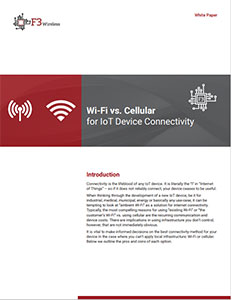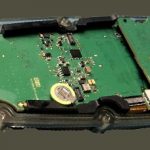White Paper: Wi-Fi vs Cellular for IoT Connectivity
Connectivity is the lifeblood of any IoT device. It is literally the “I” in “Internet of Things” – so if it does not reliably connect, your device ceases to be useful.
When thinking through the development of a new IoT device, be it for industrial, medical, municipal, energy or basically any use-case, it can be tempting to look at “ambient Wi-Fi” as a solution for internet connectivity. Typically, the most compelling reasons for using “existing Wi-Fi” or “the customer’s Wi-Fi” vs. using cellular are the recurring communication and device costs. There are implications in using infrastructure you don’t control, however, that are not immediately obvious.
Using Wi-Fi for IoT
With Wi-Fi technology, devices can communicate using multiple bands at frequencies of 2.4 GHz and 5.8 GHz. Some devices only support 2.4GHz and some support both. A device must have a Wi-Fi radio to communicate on the network and the radio comes in a few different forms.
For devices with a big processor running Linux, the radio can be a low-cost, high-performance part from Qualcomm, Marvell, RealTek or others. In this case, most of the software to implement Wi-Fi and TCP/IP runs on the host CPU and the interface to the host is usually USB, SDIO or PCIe. It normally isn’t SPI or UART because those interfaces aren’t fast enough.
For smaller, lower cost devices it’s more common to have a Wi-Fi radio module that includes the Wi-Fi and TCP/IP networking software processing. This allows for a much simpler software interface to a simple microcontroller running an RTOS or C on bare metal, typically over a UART or SPI interface.
Using Cellular for IoT
Cellular technology connects IoT devices to the Internet through the same networks used by smartphones and other mobile devices. A device must have a cellular radio and supporting circuitry, and all cellular radios include both the cellular network and TCP/IP processing needed for communications.
Your host microcontroller controls the radio with UART or USB. Some cellular modules can also appear as a network interface card via USB and allow for the TCP/IP processing to be done by the host CPU.
It is vital to make informed decisions on the best connectivity method for your device in the case where you can’t apply local infrastructure: Wi-Fi or cellular. Download our white paper to learn the pros and cons of each option.
At F3 Wireless, we specialize in making the “thing” in the Internet of Things. Our professionals can help you explore your business case needs and help you understand the trade-offs so you can choose what works best. We have options for Wi-Fi-enabled products and work with all of the major cellular module vendors. Whichever route is best for your device, F3 can take care of making it wireless.





